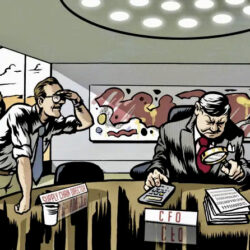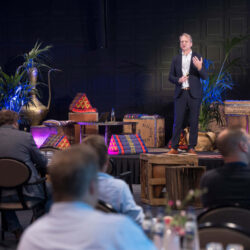Visualize ecosystems to gain better insight into bottlenecks

Many companies are still struggling with the unforeseen consequences of the coronavirus crisis and the war in Ukraine. During the SCM Talkshow held on 13 October, host Martijn Lofvers urged them to visualize their ecosystems and analyse scenarios. Alliance Automotive and Boon Edam are already taking this approach: “The main conclusion is that we have to keep collaborating with our suppliers.”
By Marcel te Lindert
Russia’s invasion of Ukraine on 24 February this year came as a surprise to a lot of companies, but not to the US military, which had first warned of the war last autumn. “We were no longer used to wars in Europe, but the American military had already prepared for it, including by modelling all the scenarios by the end of last year. They had also already analysed the possible reactions to the invasion and the subsequent follow-up reactions. Even back then, they already knew what the possible end scenarios would be,” said Martijn Lofvers, Chief Trendwatcher at Supply Chain Media and host of the SCM Talkshow.
Visualizing the ecosystem
The war is having a major impact on global supply chains, which have already suffered disruption due to the coronavirus outbreak and its subsequent consequences such as rising prices for transportation, energy, raw materials and components. Lofvers presented an illustration showing the various ripple effects that have occurred in recent years, including inflation and the threat of recession. “This illustration is one year old. I predicted the current high inflation back then. Today’s price increases mean that demand patterns are changing again. Consumers are thinking more carefully than before about what they will or won’t spend their money on. That will have an impact on the economy.”
Lofvers urged companies to take the same approach as the military: to analyse how the war in Ukraine and other geopolitical frictions will affect business operations and model the scenarios that could occur. “And look beyond the linear supply chains we all know from textbooks with just suppliers and customers. Bottlenecks can occur anywhere in the ecosystem in which companies operate. That ecosystem consists not only of suppliers and customers, but also co-packers, logistics service providers and transport companies. And don’t forget that banks, governments and NGOs exert increasing influence. If you try to visualize the entire ecosystem, you will have a much better view of where the friction is.”
Planning together with suppliers
Boon Edam and Alliance Automotive are both seeing significant shifts in demand patterns. After the coronavirus outbreak, Alliance Automotive had expected demand for automotive parts to decrease, but the opposite happened. The number of vehicles in the Benelux region grew, mainly due to rising sales of used cars. “As oil production was scaled back, the availability of by-products such as plastics, oil additives and screen wash came under pressure. We benefited very strongly from good relationships with our suppliers. Thanks to sharing information about the evolution of demand and planning together, we didn’t actually have any delivery problems,” stated Ardjan van der Blonk, Supply Chain Director of Alliance Automotive.
The growth in e-commerce caused the demand for access & security systems for data centres and fulfilment centres to suddenly triple. “We were totally unprepared for that,” said Aron Waas, Chief Supply Chain Officer at Boon Edam. “We had to scale up production rapidly despite all the challenges, and on top of that it was extremely difficult to source key components such as microchips. And now, just as we have the problems reasonably under control, the demand for products for data centres and fulfilment centres is levelling off. The erratic demand pattern means the product mix is constantly changing, which causes major problems for production planning.”
35% price increase
Boon Edam got the supply of microchips under control by giving its suppliers long commitments of up to three years, but now the supply of glass is causing problems. “We mainly use laminated glass, which requires a lot of energy in production. Due to the high gas prices, that glass now costs 35% more than a year ago. That creates new questions: Should we pass that price increase on to customers? If so, are our rates still competitive? What are our competitors doing?”
In the meantime, Waas has started looking for alternative glass suppliers. That involves a lengthy search process leading to Israel or Peru rather than Germany, which raises new issues. “One consideration is the transport of the fragile glass by boat. How can we prevent the products from becoming damaged? And the exact dimensions of the glass are not fixed in advance, so what does that mean for purchasing?” commented Waas, who – like Van der Blonk – considers himself fortunate to have good relationships with suppliers. “As a result, we have been able to retain our production slots at the German glass supplier. We provide them with a good, stable undercurrent of orders, but ideally they would have preferred to give our production slots to another customer willing to pay even more.”
Scenario modelling workshop
Earlier this year, Alliance Automotive and Boon Edam did what the US military did last autumn: model and analyse scenarios. In a workshop, both companies mapped out all the scenarios that could occur in their ecosystems. “It was a difficult but incredibly interesting and useful exercise,” stated Van der Blonk. “We had mentioned some of the scenarios in passing before, but it was only when we started exploring them in detail that the scale of their supply chain impact became apparent. We defined a number of action points that we really need to work on. The most important conclusion is that we must continue to collaborate with our suppliers.”
Waas agreed, before adding: “Another conclusion is that product design is a limiting factor. We can’t just replace one component – such as a motor or a chip – with another; it first has to go through the whole approval and testing process, which can easily take a year. That limits our flexibility and agility but it’s difficult to solve. One possible solution could be to outsource certain core activities. We still do a lot of things ourselves, but we could make our supply chain more agile by looking for a partner for some activities.”










